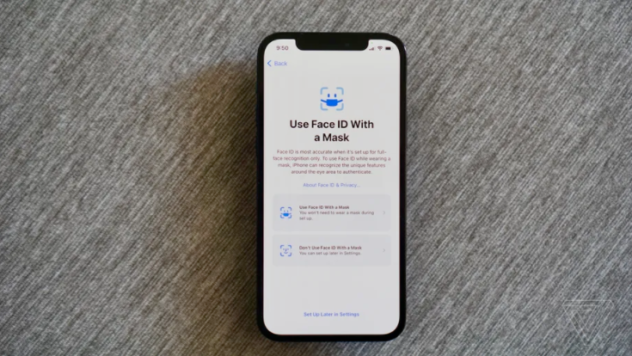
©Chaim Gartenberg/The Verge
Pre-reading questions:
I will read each question. Then, please answer them.
- What security features does your phone offer?
- Do you trust a face recognition feature? Why or why not?
Vocabulary:
I will read the words, meanings, and sample sentences. Then, repeat after me.
- buff /buhf/
- function /FUHNGK-shuhn/
- vital /VAHYT-l/
- probable /PROB-uh-buhl/
- accuracy /AK-yer-uh-see/
[noun] – a person who knows a lot about and is very interested in a particular subject
John is a huge jazz buff.
[noun] – a process that a computer or a computer program uses to complete a task
Just enable this send-to-all function to deliver several e-mails by batch.
[adjective] – absolutely necessary or important; essential
Hard work is a vital ingredient for success.
[adjective] – likely to be true or likely to happen
The probable cause of the fire was faulty wiring.
[noun] – the fact of being exact or correct
We cannot guarantee the accuracy of this data.
Article reading:
Please read the whole article. Then, I will check your pronunciation and intonation.
Apple buffs were surprised by the latest iOS update (iOS15.4) that offers a convenient feature. Users who have an iPhone 12 or later can use Face ID even if they are wearing a mask to unlock their devices. But the question is: would it be safe to use?
To enable this security function, the user has to take multiple detailed photos of their faces. The device can distinguish particular and vital parts like eyes, eyeglasses, the tip of the nose, birthmarks or freckles on the forehead, and so on. Before this became available, some iPhone users had to physically remove their masks to reveal their entire faces just to unlock their phones. It might feel kind of inconvenient if they were in a public place, or if they had not yet been able to wash or sanitize their hands before touching their face mask.
Developers have been working on this function for two years since the COVID-19 pandemic first broke out. But of course, a probable disadvantage should be considered. Apple warns consumers that “face ID is most accurate when it’s set up for full-face recognition only.” Despite its accuracy issues, it’s worth remembering that you might encounter some missed unlocks while using it.
To enable this security function, the user has to take multiple detailed photos of their faces. The device can distinguish particular and vital parts like eyes, eyeglasses, the tip of the nose, birthmarks or freckles on the forehead, and so on. Before this became available, some iPhone users had to physically remove their masks to reveal their entire faces just to unlock their phones. It might feel kind of inconvenient if they were in a public place, or if they had not yet been able to wash or sanitize their hands before touching their face mask.
Developers have been working on this function for two years since the COVID-19 pandemic first broke out. But of course, a probable disadvantage should be considered. Apple warns consumers that “face ID is most accurate when it’s set up for full-face recognition only.” Despite its accuracy issues, it’s worth remembering that you might encounter some missed unlocks while using it.
Comprehension questions
I will read each question. Then, please answer them based on the article.
- What iOS version offers the new Face ID function?
- In which models of the iPhone is the feature available?
- What examples of vital facial parts can the iPhone distinguish?
- How long have developers been working on this update?
- What does Apple warn its consumers regarding the new Face ID feature?
Discussion questions
I will read each question. Then, please answer them.
- What do you do to make sure your phone security is strong?
- What do you know about the privacy laws in your country?
- What advice would you give to smartphone users regarding privacy and security?
- Do you think Apple dominates the smartphone market today?
- What do you think of Apple’s products?